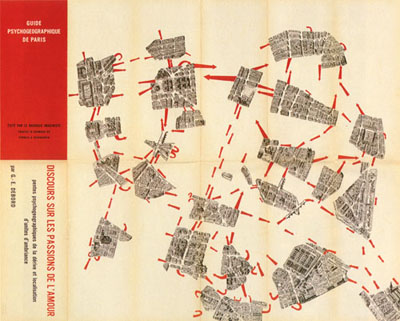project by evachromosom
|
build the city around yourself
scope creep
The Situationist International made the point of interest shift from focussing on producer / product to emphasize on a user's perspective. Drifting a geographical space (dérive), psycho-geographically mapping a content (psychogéographie), making inventive use of obsolete structures (détournement) and the revolution of everyday life-,
they made their way into established architectural practice: as city walk, cognitive mapping, temporary usage and design responding to the everyday. What about re-contextualising them within current phenomena?
Guy Debord's city map, on the right, maps a metro-user's perception of the city as opposed to traditional city maps;
It becomes visible how a topology of a map might be re-appropriated for a user's means: a scope creep.
The intention inherent in {cityscape.at} is to design space with a refined construction hidden within. It might be about playing with the obvious and about pushing boundaries, or about re-appropriating outdated topologies through inventive use. It is the manipulated moving image and immersive landscapes which are able to produce a more plastic reality than ordinary 2d imagery.
They allude to incontinuity in human perception and correspond more to the way we perceive the world.
"[..]the limitations of traditional systems of representation - which assume a fixed projection representing the fixed point of view of a static subject - are now contested
through the use of interactive and time-based media, media that radically reconfigure the range of what falls under the scope of the architectural."
Nic Clear & Iain Borden; Urbanisms, in: Bartlett Designs, Speculating with Architecture; 2009; John Wiley&Sons Ltd.
What does a dérive look like in a space informed by the loss of a particular, sole locality?
< back
< back to main page
|
|
psycho-geographic guide of Paris by Guy Debord -
image by mappingweirdstuff.wordpress.com
|

